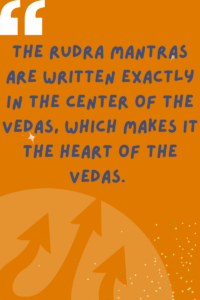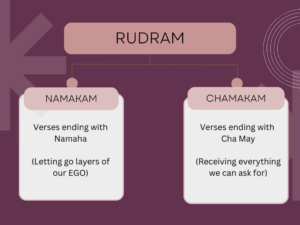

As per our Vedas, Lord Shiva created several forms of energy to perform different life functions. These energies are called Rudras.
In ancient Hindu scriptures, Rudra is described as having a terrifying appearance, with flaming hair, bow, and arrows.
In this article, we will explain the significance of Rudrabhishekam. This is a special Vedic ritual where we worship lord shiva through ‘abhishekam’, while chanting the hymns of Sri Rudram.
The Sri Rudram is a set of Vedic hymns dedicated to Lord Rudra. It is also known as Rudraprasna and comes under Krishna Yajur Veda in the Taithireeya Samhita.

The Sri Rudram is a set of Vedic hymns dedicated to Lord Rudra. It is also known as Rudraprasna and comes under Krishna Yajur Veda in the Taithireeya Samhita.
By the end of this article, you will understand why this puja is performed, and the hidden philosophy behind this puja.
To understand Rudra Abhishekam, we will look at 5 aspects:
Rudra resides in the form of energy in our body. And eleven such forms of Rudra are called Ekadasa Rudras.
Of these Eleven Rudras, Ten are in the form of Prana. Prana is the life energy that performs several functions in our body.
The five Pranas are:
Then, there are five Upa-Pranas, which are:
The prana behind these ten pranas, is the eleventh prana, which controls all the other pranas. Together all eleven pranas are the Ekadasa Rudra.
The ten Indriyas and one Manas are another group of eleven things.
Through these eleven forms, Rudra gives us suffering, and also takes away our suffering, as per our karmas. Therefore, when we perform a Rudra Abhishekam, we worship Lord Shiva in the form of these Rudras.
The Mantras chanted in a Rudrabhishekam are called Sri Rudram. It is also known as Rudropanishad, Shatarudriyam, Rudra namakam, and Rudradhyayam.
Rudram has two parts: Namakam (verses ending with Namaha) and Chamakam (Verses ending with Cha May) each with eleven sections.
The essence of Rudram is that “Everything is Rudra”.
The universe and all its living beings, and all the things which are present now and which will be created in the future are all just one, which is Rudra.
The Rudram describes the Qualities of the highest consciousness, such as Sarveshwara tattvam (One who rules everything), Sarvatmaka tattvam (One who is in all forms), Sarva antaryami tattvam (One who is inside everyone), Sarvagna tattvam, etc.
Rudra Mantras are special mantras, which can be used to perform Karmas like Abhishekam, Archana, and Homam, and Upasanas like Japam, and also to attain Moksha through Jnana.

When you need something from Ishwara, you have to let go. This may sound paradoxical, but it is true.
This concept is put into action in Rudrabhishekam.
Namakam is asking you to let go of layers of your ego and Chamakam is telling you whatever you need, will come to you, at the end of this puja.
This is why the Rishis have picked these two sets of mantras to combine and create, what we call Rudrabhishekam.
In every Shiva temple, a pot with dripping water is placed above the Shiva lingam. This practice is very similar to the Ayurvedic procedure called ‘Shirodhara’.
“Shirodhara means to slowly and steadily drip oil or other liquids on the forehead. It leads to a relaxed state of awareness that results in a dynamic psycho-somatic balance.”
Abhishekam is like watering the roots of a tree. A tree produces fruits when its roots are nourished. The results that we desire to see in this world are like the fruits of a tree.
Shiva is the root of this tree.
The universe is like one large tree. To produce the desired fruits, we tend to the roots of the tree, through the process of Abhishekam.
Next, certain Shiva lingams have the inherent property of absorbing the negative energies of the devotees to remove their tamas and ignorance.
Hence, water and milk are poured to maintain the coolness of the lingam.
Depending on how the abhishekam is performed, the theertham is either accepted or sometimes offered back into the lakes or trees.
Offering milk, water, and other dravya to a deity, during an Abhishekam is the same as pouring dravya into a yagna, offering water to the Sun god, or giving pinda daana to Pitru Devatas.
During the above-mentioned offerings, the devatas are not physically receiving these offerings.
Only the intention of offering is carried to the devatas through a subtle thought-like form. This thought-like form gives them ‘trupthi’ or satisfaction.
Several types of Rudrabhishekam have emerged, depending on the number of repetitions of the mantras, and the kind of samagri offered to Rudra.
Each type of Rudrabhishekam has a different impact on the Yajamani (doer).
Let’s now see how the type of Rudrabhishekam changes based on the permutation and repetition of the Rudra mantras.
Apart from this, we can add a specific procedure known as Paashupata Prayoga Vidhi, for specific wishes or sankalpam.
Rudram has the quality to address different kinds of difficulties. In this Vidhi, there are many types of Paashupatas like Amrutha Paashupatam, Roga-harana Paashupatam, Kanya Paashupatam, Vivaha Paashupatam, etc.
For each specific type of wish, a specific Dravya is suggested in the Shiva Purana, Skanda Purana, and Linga Purana for performing Pashupata Abhishekam.
For example, Rudrabhishekam with a wish of the marriage of an unmarried girl is called Vara Paashupata Abhishekam, and Kanya Paashupata Abhishekam for the marriage of an unmarried boy. Both of these abhishekams use powdered sugar.
Similarly, Abhishekam can be performed with:
The main purpose of rudrabhishekam is to realize the true identity of the Brahman.
The Vedas describe that Rudra is everywhere.
He is in the pleasant and the unpleasant, in the hot and the cold, in the tree, in the rocks, in the thief, in the king, and all the things which are present now and which will be created in the future, all macroscopic, and all microscopic. He is nature, He is time, and He is you.
After performing the abhishekam, he/she has to train the mind to start seeing Rudra in everything and everyone.
Cultivating this attitude is one of the main purposes of Rudrabhishekam.
When the pujari is chanting the Vedic mantras and performing an abhishekam, and as the Dhravya (samagri) is falling upon the lord, one must view the Shiva lingam as the entire universe.
We must imagine that streams of amrutham are falling on this lingam to drench and cool the lingam continuously.
This is the most crucial aspect of Rudrabhishekam and has the ability to transform our mindset.
Namakam is a list of names of Amrutha Tattva, which means, ‘that which does not die’, and that which does not come to an end can be called Parameshwara.
We can describe water, and its properties, but unless we drink water, we cannot truly experience it.
Similarly, we try our best to describe Rudrabhishekam. All this information is to help us appreciate this puja but it does not come close to what it really feels like when one is fully involved in worshipping Shiva with their mind, body, and soul.
May the Ardhanarishwara bless us all with the ultimate spiritual knowledge in our life !!
